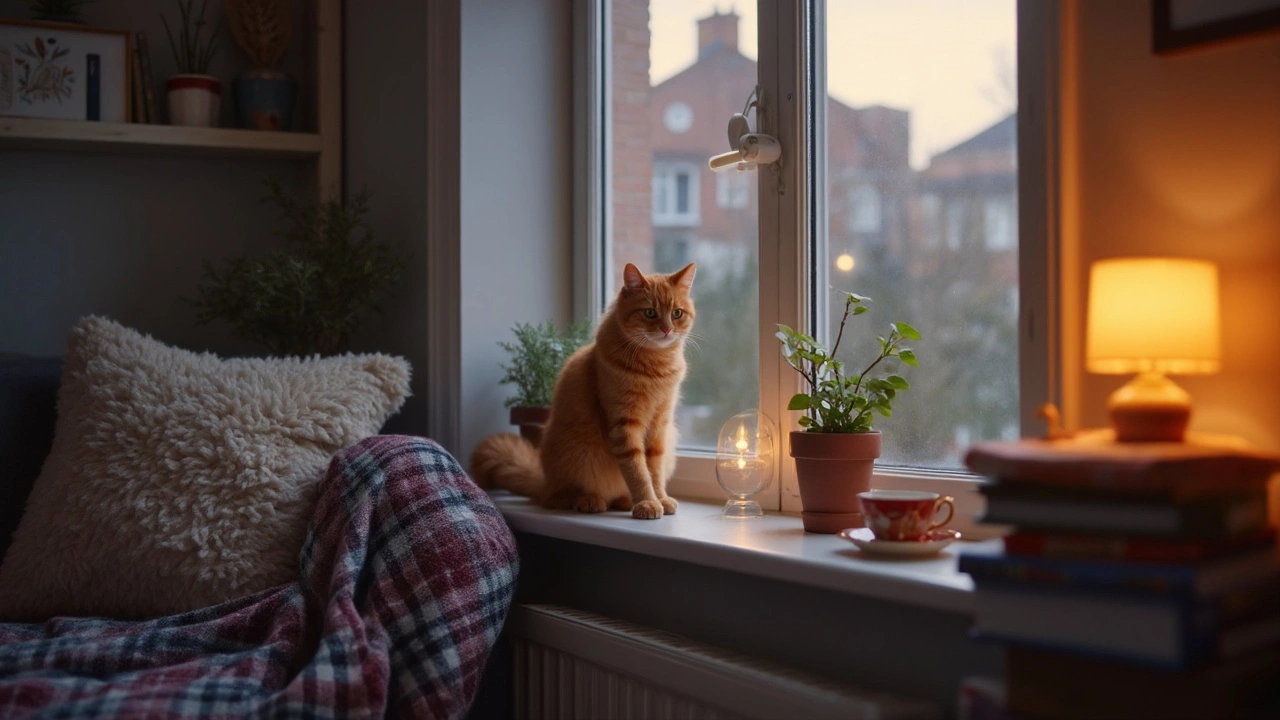If you’ve ever watched your cat vault across the living room at 2 a.m., you know just how inventive those little furballs can be. They're not the only ones learning new moves, though. A lot of pet owners wonder if their SimpliSafe system is about to start a dance party every time Whiskers runs, jumps, or even sighs in the hallway. False alarms are annoying, sure, but most of us are more concerned with the cops showing up at our door or waking the whole house in the middle of the night. So, is SimpliSafe really ready for life with your four-pawed roommate? Or do you need to worry about your security system going haywire? There’s a reason more than 4 million homes in the U.S. use SimpliSafe, and the answer isn’t as simple as yes or no. Let’s get to the bottom of this with hard facts, tips from real users, and a few key settings most folks don’t even realize affect their system’s sensitivity to pets.
How SimpliSafe Motion Sensors Really Work—And Why Your Cat’s Parkour Matters
SimpliSafe, like many home security systems, relies on passive infrared (PIR) motion sensors to detect movement. Here’s how it works: the sensor measures infrared energy (that’s heat!) in its field of view. When it picks up rapid changes in heat—say, a human moving across the room—it trips the alarm. Now, here’s where cats come in. Your typical housecat might weigh anywhere from 6 to 15 pounds, much less than a human, and puts out less heat. SimpliSafe specifically advertises their motion sensors as being “pet-friendly” for animals under 50 pounds. But "pet-friendly" isn’t the same as pet-proof.
Let’s dig deeper. The trick is in the sensor’s angle and how it’s placed in your home. Most SimpliSafe motion sensors scan for movement above a certain height. There’s a common myth that cats—because they’re smaller—will never trip these sensors. But if your cat is the athletic type (you know, the one who thinks your kitchen cabinets are a climbing wall), the risk goes up. According to SimpliSafe’s official guidance, installation about four to five feet off the ground and aimed away from furniture or countertops reduces false alarms. Think of how your cat moves—are the favorite naps spots high up? Is the cat tree right in the sensor’s field of view? These details matter more than you might expect.
By the way, according to security industry data in 2023, about 18% of all motion sensor false alarms in the U.S. are actually triggered by pets. But only a fraction of those are caused by cats—dogs (especially bigger ones) are the usual suspects. Still, it’s best to take precautions. SimpliSafe’s own user forums show that cats under 30 pounds almost never cause issues if the sensors are installed correctly. But the closer your cat gets to that 50-pound mark (looking at you, Maine Coon owners), or the higher they jump, the greater the risk they can trigger it.
This is where the difference between PIR sensors and so-called "dual tech" sensors comes in. Dual tech models combine infrared detection with microwave sensing and are even less likely to be fooled by a cat. SimpliSafe’s standard motion sensors, though, are single tech—meaning they rely on infrared readings alone. One SimpliSafe tech put it simply:
“If your cat’s big enough and jumping up where the sensor can see their body heat, there’s always a possibility. Placement is everything.”So, if your cat is only prowling the floors, you’ll probably be fine. But if they’re a high flier, you’ll want to pay extra attention to the next section.
Real-World Experiences: What Pet Owners Say About SimpliSafe And Their Cats
Let’s get personal for a second. Thousands of SimpliSafe users share their stories on Reddit, in product reviews, and in the company’s own community forum. If you ask around, you’ll quickly discover cats do occasionally set off SimpliSafe, but it’s usually because of some very specific situations—like a sensor aimed right at a cat tree, or a Siamese who makes an Olympic leap onto the mantlepiece.
Take Eric from Cleveland, for example. His 14-pound tabby, Bean, triggered three alarms in one week. Turns out, the sensor was mounted opposite the bookshelf (Bean’s favorite launchpad). Once Eric moved the sensor toward an empty patch of wall, he didn't have another false alarm for months. Then there’s Sam in Dallas, whose SimpliSafe never once tripped for her two 8-pound shorthairs—she’d placed all her sensors low, aimed away from the windows and high surfaces.
The patterns are clear:
- Cats on the floor rarely cause problems.
- Jumpers, however, can trigger alarms if the sensor sees them above its "pet zone."
- Sensor placement is the #1 culprit.
- Customizing sensitivity helps, but it doesn’t fix a poorly placed sensor.
SimpliSafe also lets you adjust some sensors through their app or base station, setting motion sensitivity to low, medium, or high. Most users with cats find that the medium or low setting works great. According to a 2024 Consumer Reports analysis, about 92% of SimpliSafe owners never report a false alarm from their pets when using proper setup. The remaining 8%? Almost every time, it came down to location and what the cat was up to.
Just as interesting, there are stories from users with unusual pets: one woman posted about her giant rabbit tripping the sensor, while a user with five ferrets (yes, really) said they eventually learned to work around the system. Cats, though, seem to have the best odds of avoiding accidental trips, so long as they aren’t part mountain lion.
If you’re wondering how police and alarm monitoring respond to pet-triggered alarms, policies do vary by region. Most counties require two verifications (like a camera check or a phone call) before dispatching emergency services. A false alarm most often results in a warning or, at worst, a small fine after repeated incidents—rarely would a single feline-induced trip cause big trouble.
| Sensor Placement | False Alarm Frequency |
|---|---|
| Opposite high furniture (cat tree, bookshelf, mantle) | High |
| Over open wall, away from climbable objects | Low |
| Near windowsills (cats like to perch!) | Medium |
| In corners, aimed at entryways only | Very Low |
These real-world stories prove that while SimpliSafe is pet-friendly, it still needs a personal touch. No two cats—or homes—are quite the same. Next, let’s break down some data and expert tips to guarantee your home stays both secure and false-alarm free.

Expert Installation Tips: How to Cat-Proof Your SimpliSafe Motion Sensors
A lot of folks just slap a sensor up anywhere and call it good, but if you’re living with cats, that’s a recipe for trouble. Here are some proven strategies—the kind even SimpliSafe’s pro installers recommend (yeah, I called and asked):
- Height matters: Mount sensors 4-5 feet above the floor, never right at cat head-level.
- Angle is everything: Point sensors away from places your cat likes to perch—mantlepieces, bookshelves, window ledges.
- Low sensitivity first: Start sensors on the lowest sensitivity if you have an active cat, and bump it up if you’re not getting enough coverage.
- Move furniture as needed: If your sensor points at a cat tree, try moving it—or better yet, move the tree.
- Test during prime cat hours: Arm your system in "away mode" when you’re home and watch your cat’s behavior. There’s no substitute for a dry run.
- Use Entry Sensors: For high-traffic rooms, sometimes it’s better to skip motion sensors and use door or window sensors instead. These don’t react to movement or heat, so there’s zero risk of a fur-triggered false alarm.
- Masking tape trick: If you rent or can’t move the sensor, use a small strip of tape to block the lower part of its lens, narrowing what it can "see." This quick hack has saved more than a few landlords’ sanity.
- Consult the app: Use the SimpliSafe app to adjust and experiment—most sensors can be renamed, tested, and fine-tuned right from your phone.
Think like your cat. Picture their favorite routes—do they run the baseboards, leap onto counters, or just nap under the chair? Start there. Many professional installers also recommend testing sensors with a hairdryer set on "warm," waving it through the detection field to mimic a cat’s body heat. It’s low-tech, but surprisingly effective. The goal: ensure the sensor easily spots human-sized movement but ignores the heat signature of a loafing tabby.
Here are a few facts for the tech-minded. SimpliSafe sensors have what’s called “pet immunity” up to animals 50 pounds or lighter. PIR tech detects objects above a certain "mass," which is really a combination of weight, heat, and speed. A running child will always trip the alarm, but a slow-moving or curled-up cat usually won’t. But, climbing cats who bring their entire body above the protected area—like on top of the fridge? That can still trigger the system.
If you ever do get a false alarm, the SimpliSafe app logs which sensor tripped and when. Use this info to tweak your setup. Some users even swap sensors around until they find the “sweet spot”—a process that might take an afternoon, but saves a lot of stress down the road.
Do’s and Don’ts: What To Avoid If You Want Pet-Proof Home Security
By now, you’ve heard how sensor placement, sensitivity settings, and furniture all affect your SimpliSafe’s success around cats. But a few mistakes crop up time and again, so here’s what you really need to know for peace of mind.
- Don’t mount sensors above doors or windows where cats like to climb.
- Don’t use motion sensors in every single room—especially where pets eat, sleep, or roam most.
- Don’t set every sensor on “high” just because you want to be safe—it’s more likely to pick up pets.
- Don’t ignore false alarms hoping the problem will go away. Repeated alarms can lead to fines or system shut-off.
- Do call SimpliSafe support if you can't troubleshoot a recurring problem—they really do help, and sometimes send free replacement sensors if a unit is defective.
- Do combine motion detection with door/window sensors for extra reliability (plus, they help even if your cat decides to learn lock-picking).
- Do talk to your neighbors if you’ve had police respond to a pet-triggered alarm. A quick heads-up can keep small issues from snowballing.
- Do clean your sensors every few months—dust and pet hair can cause their own problems.
If you’re shopping for a system and your cat is a known troublemaker, you might want to consider systems with dual tech sensors or ones that let you create virtual boundaries (like geofencing). Some newer models use cameras with built-in animal detection features to tell pets from people, though SimpliSafe itself doesn’t offer that yet. However, you can add SimpliSafe security cameras, which let you visually confirm what set off an alarm before you panic—or call animal control out for “an intruder” that’s actually your confused housecat.
At the end of the day, most SimpliSafe cat owners have zero trouble after spending a little time setting things up smart. Cats bring a lot of unpredictability to our lives, but your home security doesn't have to be one more thing to stress over. Place your sensors wisely, keep an eye on that app, and remember: your furball probably won’t outsmart the system. But then again, never bet against a cat.

